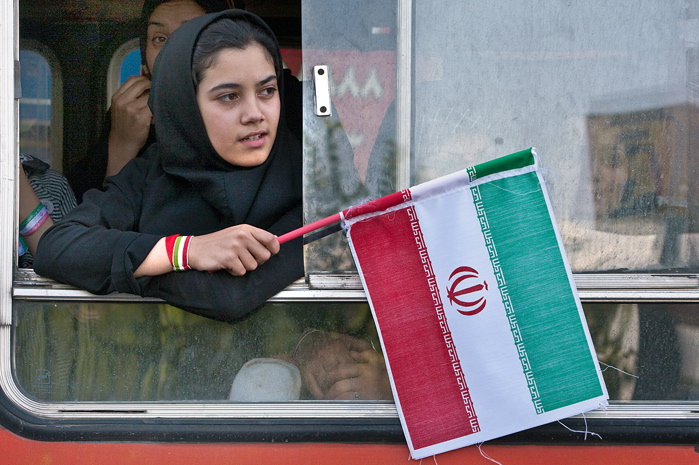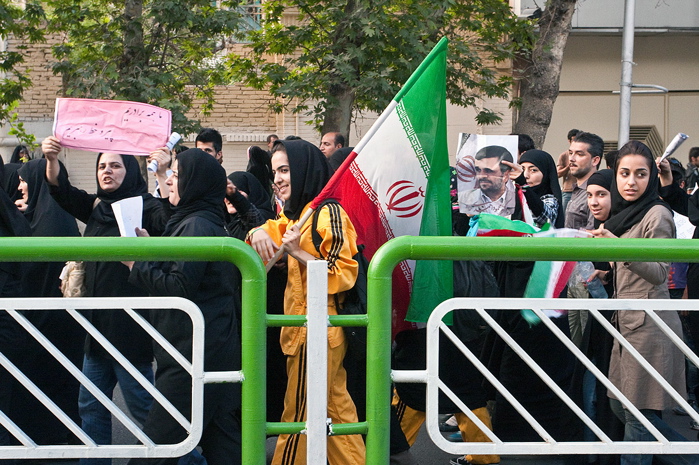According to Ervand Abrahamian, a scholar of Iran’s contemporary history, George Rudé’s observation that “perhaps no historical phenomenon has been so thoroughly neglected by historians as the crowd” is particularly true about the Middle East.1
While European journalists have invariably portrayed oriental crowds as “xenophobic mobs” hurling insults and bricks at Western embassies, local conservatives have frequently denounced them as “social scum” in the pay of the foreign hand, and radicals have often stereotyped them as “the people” in action. For all, the crowd has been an abstraction, whether worthy of abuse, fear, praise, or even of humour, but not a subject of study.2
Abrahamian’s classic text on the subject called “The Crowd in Iranian Politics 1905-1953” describes the role of the crowd in politics and conceptualizes, for the first time, the social and class makeup of the Iranian crowd in the country’s transformation from a pre-industrial to a semi-industrial national economy and, by doing so, invents a language with which to study the Iranian political crowd and its history.3
Written in 1968, Abrahamian’s text unfortunately does not bear witness to the crucial role that the crowd played in the political developments that culminated in the Islamic revolution of 1978, a task Abrahamian finely accomplishes later in his magnum opus Iran between Two Revolutions.4 Abrahamian is Iran’s first structuralist historian who rejects the prominence of events and personalities as clues to history and is rather interested in the social makeup of Iran and its various movements for political power, an energy that, according to him, finds its proper medium of expression in the crowds and demonstrations.
Events of the past few weeks surrounding the Iranian presidential race and its aftermath not only were the most recent example of the social force called the Iranian political crowd, they were also a new chance for us to reexamine Abrahamian’s thesis regarding the political crowd in the age of global spectacle. In doing so, a sudden interest in the reform movement and its social makeup is not enough. To understand the phenomenon of political crowd, one needs to also cross to the other side and study the pro-Ahmadinejad and the pro-government crowds.
The Iranian Islamic Revolution of 1978 was the first of its kind, coinciding with the rise of the spectacular global media that acted as a mirror reflecting the image of the street crowd onto the pages of newspapers, magazines, and on broadcast network television. Ayatollah Khomeini quickly understood and incorporated this mirror in his political machinery by surrounding himself with Western-educated members of the Iranian intelligentsia who were able to reflect his views to Europeans, and through them to the Iranian educated class. It was in the global media that the text about the Ayatollah and the revolution appeared alongside the images of the crowds in the streets of Tehran, giving meaning to the people and defining their leadership.
Today, the new wave of protests in Iran is taking place in a different media environment where YouTube, Facebook, Twitter, blogs, and text messages have replaced Time, Newsweek, Paris Match and Der Spiegel as the international currency of news. At the same time, Iran is going through a kind of spectacular awakening in its Debordian sense.5 The development of a post-Persian Gulf War consumer society in Iran has had similar effects on Iran to those of developments in Europe and America after World War II. After centuries of resisting the temptation of images as a needed addition to or a replacement for the centrality of text and literature in the creation of social meaning, globalization of the last two decades has finally forced the Iranian society to take images, particularly their own image, very seriously. This new spectacular awakening among Iranians about the role of images, visual aesthetics, and physical beauty was apparent everywhere in the presidential campaign and its aftermath. The reliance on the spectacle to reflect, rather than to engage directly in, the situation actually could be preventing much larger violence, since appearances on a spectacular stage that in our age involves and relies on the Internet are not limited to the pro-reformist crowd: countering the wave of visual creativity in support of reform, the Islamist friends of Ahmadinejad were also using a large amount of imagery, alongside fashion items and accessories, to identify themselves, to promote their candidate, and to fight the propaganda of the opposition.
| Mohammad Javad Jahangir, The Invisible Crowd, 11 July – 7 September 2009. Go to dadabase.ca/crowd_jahan_00.php to view the online exhibition The Invisible Crowd.  
|
To counter the green colour that earlier in the campaign had become the symbol of the reformist candidate Mir Hussein Moussavi’s supporters, the Ahmadinejad campaign picked the Iranian three-colour flag as its symbol. In this reversal of the usual identities, Moussavi, the closest candidate to secular nationalists, decided to use an Islamic green colour to deflect the accusation of not being Islamic enough, while Ahmadinejad used the flag and its nationalist association to deflect the accusation of religious extremism.
Protests and demonstrations are not new in Iran. In fact, pro-government demonstrations have been institutionalized by the state since the dawn of the Islamic Republic and have been used to both legitimize and assert state power. The sudden interest by the global media in the anti-government protests in Iran has made the world audience familiar with the faces and social makeup of the pro-reform crowd. Yet, a shroud of mystery surrounds the pro-Ahmadinejad crowd. The dual nature of the Iranian society along the lines of culture, education, region, and class has made it easy for both groups, pro-government and pro-reformist, to claim the title of “people.” Only a close study of the makeup of these crowds may allow us to come to an understanding of the Iranian society and its complex structure.
Unlike the reformist crowd that has quickly emerged through the recent presidential campaign of Mir Hossein Moussavi, the pro-Ahmadinejad crowd has a long, thirty-year history in the making. A once official crowd in service of the state, the Ahmadinejad crowd has been made up mostly of those who returned to the street, and the ballot box, after a decade, to launch their own reform against corruption and to renew their support for the regional resistance against the USA and Israel.
This invisible crowd, particularly those not working for the security services and government agencies, was asked by the state to stay home throughout the riots to prevent the situation from turning into civil war. Nevertheless, they had been present at the ballot box and at certain demonstrations including the Friday prayer given by the Supreme Leader Ayatollah Khamenei. Captured by Mohammad Javad, they are here to show, at least to themselves, that they exist, and to refute the reformist candidate’s claim that the reelection of Ahmadinejad was anything but the democratic will of the people.
The Invisible Crowd exhibition borrows its name from a sign that has inspired the work. During one of the early pro-Ahmadinejad rallies before the vote, Mohammad Javad Jahangir, who was present at the scene, noticed a sign in the crowd that poked fun at the lack of the global media coverage of large pro-Ahmadinejad demonstrations. The sign depicted a television containing a still frame of an empty city street with the CNN logo at the bottom. Underneath the television set read the words “We are the invisible crowd for the Western media.”
With this series of photographs, Mohammad Javad is attempting to map the social and economic makeup of the pro-government masses in Iran. Ignored by the modern secular middle class as uneducated, ignorant, and/or hired bodies, the pro-government crowd has been, and continues to be, an important part of the political developments in Iran.
| Mohammad Javad Jahangir is an Iranian artist based in Tehran, with a background in Islamic studies at a seminary. He has studied and worked with Abbas Kiarostami, Reza Abedini, and Mohsen Rastani on several projects. His work has been featured by BBC, Reuters, and other international news organizations. He graduated from Tarbiate Moalem University of Tehran in January 2009. |
1 G. Rudé, The Crowd in History, 1730-1848 (New York 1964), p. 3.
2 E. Abrahamian, “The Crowd in Iranian Politics, 1905-1953,” Past & Present, No. 41 (Oxford, 1968), p. 184-210, <dadabase.ca/crowd.pdf>.
3 Ibid.
4 E. Abrahamian, Iran between Two Revolutions (Princeton, 1982).
5 G. Debord, The Society of The Spectacle (Cambridge, 1989).
Mohammad Salemy is an artist and curator of the DADABASE Gallery (formerly at 183 East Broadway, Vancouver, British Columbia, Canada — now exclusively online). He is also known for his writing and activism. A graduate of the Emily Carr Institute of Art and Design, he is currently an MA student at the University of British Columbia. His work has been included in solo and group exhibitions locally and nationally. He is currently working on a group exhibition for Artspeak Gallery, scheduled to open on 11 September 2009, titled “Race: Proposals in Truth and Reconciliation.” This article was first published on the Web site of the DADABASE Gallery; it is reproduced here for educational purposes. Download Salemy’s article in Persian: <dadabase.ca/press_crowd_fa.pdf>.
